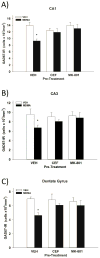MDMA decreases glutamic acid decarboxylase (GAD) 67-immunoreactive neurons in the hippocampus and increases seizure susceptibility: Role for glutamate
- PMID: 27773601
- PMCID: PMC5123907
- DOI: 10.1016/j.neuro.2016.10.011
MDMA decreases glutamic acid decarboxylase (GAD) 67-immunoreactive neurons in the hippocampus and increases seizure susceptibility: Role for glutamate
Abstract
3,4-Methylenedioxy-methamphetamine (MDMA) is a unique psychostimulant that continues to be a popular drug of abuse. It has been well documented that MDMA reduces markers of 5-HT axon terminals in rodents, as well as humans. A loss of parvalbumin-immunoreactive (IR) interneurons in the hippocampus following MDMA treatment has only been documented recently. In the present study, we tested the hypothesis that MDMA reduces glutamic acid decarboxylase (GAD) 67-IR, another biochemical marker of GABA neurons, in the hippocampus and that this reduction in GAD67-IR neurons and an accompanying increase in seizure susceptibility involve glutamate receptor activation. Repeated exposure to MDMA (3×10mg/kg, ip) resulted in a reduction of 37-58% of GAD67-IR cells in the dentate gyrus (DG), CA1, and CA3 regions, as well as an increased susceptibility to kainic acid-induced seizures, both of which persisted for at least 30days following MDMA treatment. Administration of the NMDA antagonist MK-801 or the glutamate transporter type 1 (GLT-1) inducer ceftriaxone prevented both the MDMA-induced loss of GAD67-IR neurons and the increased vulnerability to kainic acid-induced seizures. The MDMA-induced increase in the extracellular concentration of glutamate in the hippocampus was significantly diminished in rats treated with ceftriaxone, thereby implicating a glutamatergic mechanism in the neuroprotective effects of ceftriaxone. In summary, the present findings support a role for increased extracellular glutamate and NMDA receptor activation in the MDMA-induced loss of hippocampal GAD67-IR neurons and the subsequent increased susceptibility to evoked seizures.
Keywords: Excitotoxicity; GABA; Glutamate; MDMA.
Copyright © 2016 Elsevier B.V. All rights reserved.
Conflict of interest statement
The authors declare no competing financial interests.
Figures






References
-
- Abad S, Junyent F, Auladell C, Pubill D, Pallas M, Camarasa J, Escubedo E, Camins A. 3,4-methylenedioxymethamphetamine enhances kainic acid convulsive susceptibility. Prog Neuropsychopharmacol Biol Psychiatry. 2014;54:231–242. - PubMed
-
- Arellano J, Munoz A, Ballesteros-Yanez I, Sola R, DeFelipe J. Histopathology and reorganization of chandelier cells in the human epileptic sclerotic hippocampus. Brain. 2004;127:45–64. - PubMed
Publication types
MeSH terms
Substances
Grants and funding
LinkOut - more resources
Full Text Sources
Other Literature Sources
Medical
Miscellaneous

